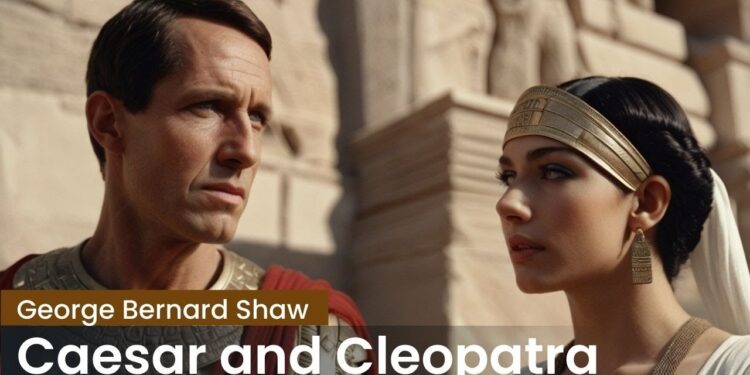Introduction
Caesar And Cleopatra Summary By George Bernard Shaw is a play written by George Bernard Shaw, first performed in 1898. The play explores the complex relationship between Julius Caesar, the Roman general and statesman, and Cleopatra, the young queen of Egypt. Shaw’s portrayal of these historical figures is both humorous and philosophical, focusing on themes of power, politics, and the dynamics of gender and leadership. Through witty dialogue and clever characterizations, Shaw delves into the nature of ambition, authority, and the human condition, offering a fresh perspective on one of history’s most famous pairings.
The play is set against the backdrop of ancient Egypt during a time of political upheaval and intrigue. Shaw presents Cleopatra not merely as a seductress but as a multifaceted character who grapples with her identity, the responsibilities of leadership, and her evolving relationship with Caesar. The play is notable for its exploration of the cultural clash between Roman and Egyptian ideals, as well as Shaw’s unique approach to historical figures, infusing them with modern sensibilities and philosophical insights.Caesar And Cleopatra Summary By George Bernard Shaw
Plot Summary
Setting and Context
The play unfolds in Alexandria, Egypt, during the 1st century BCE, amidst the backdrop of political turmoil. Egypt is in a state of disarray, with Cleopatra struggling to assert her authority amid the challenges posed by her brother Ptolemy and the ambitions of Roman leaders, particularly Julius Caesar. Shaw’s setting emphasizes the grandeur and decadence of ancient Egypt, juxtaposed with the political machinations that define the era.Caesar And Cleopatra Summary By George Bernard Shaw
READ MORE
Characters
- Julius Caesar: A prominent Roman general and statesman, characterized by his intelligence, charisma, and political acumen. In the play, he represents Roman ideals of power and leadership, but he also exhibits a softer side in his interactions with Cleopatra.
- Cleopatra: The young queen of Egypt, depicted as intelligent, ambitious, and resourceful. Cleopatra’s character evolves throughout the play, showcasing her growth from a somewhat naive ruler to a more self-aware and politically savvy leader.
- Ptolemy: Cleopatra’s younger brother, whose ambitions and conflicts with Cleopatra highlight the political instability in Egypt. He represents the threat to Cleopatra’s rule and the chaos of their familial dynamics.
- Ftatateeta: Cleopatra’s nurse and confidante, who serves as a foil to Cleopatra’s youthful exuberance. Ftatateeta provides wisdom and guidance, often reminding Cleopatra of her responsibilities as queen.
- The Egyptian Nobles: A group of characters who represent the political factions and interests within Egypt, often reflecting the larger societal tensions of the time.Caesar And Cleopatra Summary By George Bernard Shaw

Summary of Events
Act 1: The Arrival of Caesar
The play opens in Alexandria, where Cleopatra is introduced as a young and somewhat inexperienced ruler. She is aware of the political instability in her kingdom but is more concerned with her own desires and ambitions. The arrival of Julius Caesar marks a turning point in her life. Cleopatra, eager to assert her authority, attempts to seduce Caesar, seeing him as a means to strengthen her position.Caesar And Cleopatra Summary By George Bernard Shaw
Caesar arrives in Alexandria after defeating Pompey in battle, seeking to consolidate power and stabilize the region. He is met with both admiration and resistance from the Egyptian nobility, who are wary of his influence. Shaw cleverly contrasts Caesar’s composed demeanor with Cleopatra’s youthful impulsiveness, setting the stage for their evolving relationship.
Act 2: The Power Play
In their initial encounters, Cleopatra and Caesar engage in a battle of wits, with Cleopatra trying to impress Caesar and gain his favor. Shaw uses their dialogue to explore themes of power dynamics and gender roles. Cleopatra is initially portrayed as somewhat naive, but as the act progresses, her intelligence and political acumen begin to surface.
Cleopatra’s nurse, Ftatateeta, plays a crucial role in advising her about the implications of her relationship with Caesar. While Cleopatra is captivated by Caesar’s charm, she must also contend with the political realities of her situation. The tension between her personal desires and her responsibilities as queen becomes increasingly pronounced.Caesar And Cleopatra Summary By George Bernard Shaw
As the act unfolds, Caesar recognizes Cleopatra’s potential as a leader. He sees in her the qualities necessary to unite Egypt and strengthen his own political position. This acknowledgment of Cleopatra’s capabilities marks a significant shift in her character, as she begins to embrace her role as a ruler rather than merely a pawn in the political game.
Act 3: The Climax of Ambition
In the third act, the relationship between Caesar and Cleopatra deepens as they navigate the challenges of leadership and ambition. Cleopatra begins to understand the complexities of her position, realizing that her allure is not enough to secure her power. Caesar, too, grapples with the responsibilities of leadership, recognizing that his desire for conquest must be tempered by wisdom and strategy.
The political machinations surrounding them intensify, particularly as Ptolemy’s forces pose a threat to Cleopatra’s reign. The conflict between the siblings symbolizes the larger struggles for power in Egypt. Cleopatra’s growing self-awareness and determination to protect her kingdom become evident as she allies herself with Caesar against her brother.Caesar And Cleopatra Summary By George Bernard Shaw
Shaw’s exploration of ambition is central to this act, as both characters confront their desires for power and influence. The dialogue is rich with philosophical insights, with Caesar and Cleopatra exchanging views on leadership, the nature of authority, and the responsibilities that come with power.
Act 4: The Consequences of Power
As the play progresses, the consequences of ambition become increasingly apparent. Cleopatra’s transformation into a more politically savvy ruler is juxtaposed with the moral dilemmas she faces. She begins to recognize the sacrifices required to maintain her power, and the complexities of her relationship with Caesar grow more intricate.
The act culminates in a confrontation between Cleopatra and Ptolemy’s forces. The stakes are high as Cleopatra must assert her authority and demonstrate her resolve to protect her kingdom. The dynamics of power shift as Caesar and Cleopatra work together to face the external threats to her reign.
Throughout this act, Shaw delves into the philosophical implications of power, exploring the moral ambiguities inherent in leadership. Cleopatra’s growth is highlighted, as she grapples with the weight of her responsibilities and the consequences of her actions.
READ MORE
Act 5: The Resolution
The final act of the play brings resolution to the tensions between the characters. Cleopatra’s evolution is complete as she embraces her role as a leader, showcasing her newfound confidence and political acumen. The relationship between Caesar and Cleopatra deepens, as they recognize the value of their alliance.
In a poignant moment, Cleopatra reflects on the nature of power and its impact on her identity. Shaw uses this introspection to highlight the complexities of leadership and the sacrifices that come with it. The play concludes with a sense of hope for the future, as Cleopatra emerges as a formidable leader, ready to navigate the challenges ahead.
Themes
1. Power and Authority
One of the central themes of Caesar and Cleopatra is the exploration of power and authority. Shaw examines the complexities of leadership through the characters of Caesar and Cleopatra, highlighting the moral dilemmas and responsibilities that accompany positions of power. The play raises questions about the nature of authority and the sacrifices required to maintain it.Caesar And Cleopatra Summary By George Bernard Shaw
2. Gender Dynamics
Shaw’s portrayal of Cleopatra challenges traditional gender roles, depicting her as a strong and intelligent leader rather than a mere seductress. The dynamic between Cleopatra and Caesar reflects the tensions between masculinity and femininity in positions of power. Cleopatra’s evolution throughout the play emphasizes the potential for female leadership and the complexities of gender in political contexts.
3. Ambition and Consequences
Ambition serves as a driving force for both Caesar and Cleopatra, shaping their actions and decisions. Shaw explores the consequences of their ambitions, illustrating the moral ambiguities inherent in the pursuit of power. The characters grapple with the impact of their desires on their identities and relationships, raising questions about the costs of ambition.Caesar And Cleopatra Summary By George Bernard Shaw
READ MORE
4. Cultural Clash
The play highlights the cultural clash between Roman and Egyptian ideals, reflecting the broader tensions of the time. Shaw uses the interactions between the characters to explore the differences in their worldviews, showcasing the complexities of identity and cultural exchange. The play serves as a commentary on the nature of civilization and the challenges posed by differing perspectives.
5. Transformation and Growth
The theme of transformation is central to the narrative, particularly in Cleopatra’s character arc. Her journey from a somewhat naive ruler to a confident and politically savvy leader symbolizes the potential for personal growth in the face of adversity. Shaw emphasizes the importance of self-awareness and adaptability in leadership, showcasing how experiences shape identity.Caesar And Cleopatra Summary By George Bernard Shaw

Conclusion
Caesar and Cleopatra is a thought-provoking play that delves into the complexities of power, ambition, and gender dynamics through the lens of history. George Bernard Shaw’s nuanced portrayal of Julius Caesar and Cleopatra challenges conventional representations of these figures, offering a fresh perspective on their relationship and the political landscape of ancient Egypt.Caesar And Cleopatra Summary By George Bernard Shaw
Through witty dialogue, philosophical insights, and rich character development, Shaw invites audiences to reflect on the nature of authority, the consequences of ambition, and the transformative power of leadership. The play remains relevant today, resonating with contemporary discussions about gender, power, and the complexities of human relationships.
FAQ
1. What is the main theme of Caesar and Cleopatra?
The main theme of the play revolves around power and authority, exploring the complexities and moral dilemmas that accompany leadership. Shaw delves into the nature of ambition and the consequences of seeking power, as well as the dynamics of gender in positions of authority.Caesar And Cleopatra Summary By George Bernard Shaw
2. How does Shaw portray Cleopatra in the play?
Shaw portrays Cleopatra as a multifaceted character, showcasing her intelligence, ambition, and growth as a leader. Rather than a mere seductress, she is depicted as a politically savvy ruler who grapples with her responsibilities and identity throughout the narrative.
3. What role does Julius Caesar play in the story?
Julius Caesar serves as both a romantic interest and a political ally for Cleopatra. His character embodies Roman ideals of leadership, and his interactions with Cleopatra highlight the tensions between their cultures and the complexities of power dynamics.
4. How does the play explore gender dynamics?
The play challenges traditional gender roles by presenting Cleopatra as a strong and capable leader. Shaw uses the dynamic between her and Caesar to examine the complexities of masculinity and femininity in positions of power, emphasizing the potential for female leadership.
5. What is the significance of the cultural clash in the play?
The cultural clash between Roman and Egyptian ideals serves as a backdrop for the characters’ interactions, reflecting the broader tensions of the time. Shaw uses this contrast to explore themes of identity, civilization, and the challenges posed by differing perspectives.Caesar And Cleopatra Summary By George Bernard Shaw
6. How does ambition play a role in the characters’ development?
Ambition drives both Caesar and Cleopatra, shaping their actions and decisions throughout the play. Shaw explores the consequences of their ambitions, illustrating the moral ambiguities inherent in the pursuit of power and the impact on their identities and relationships.Caesar And Cleopatra Summary By George Bernard Shaw
7. What transformations does Cleopatra undergo in the play?
Cleopatra undergoes significant transformation throughout the play, evolving from a somewhat naive ruler to a confident and politically savvy leader. Her journey symbolizes the potential for personal growth in the face of adversity, emphasizing the importance of self-awareness and adaptability.
8. What is the play’s overall message?
The overall message of Caesar and Cleopatra emphasizes the complexities of power, the importance of leadership, and the moral dilemmas inherent in ambition. Shaw invites audiences to reflect on the nature of authority and the transformative power of relationships.
READ MORE

















